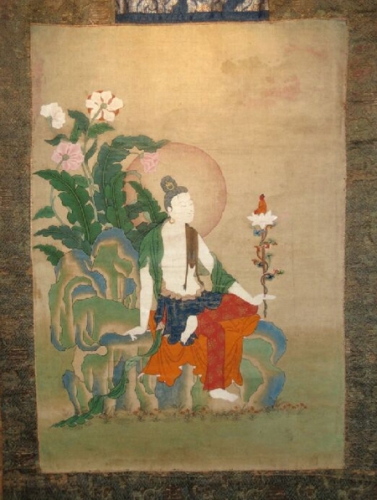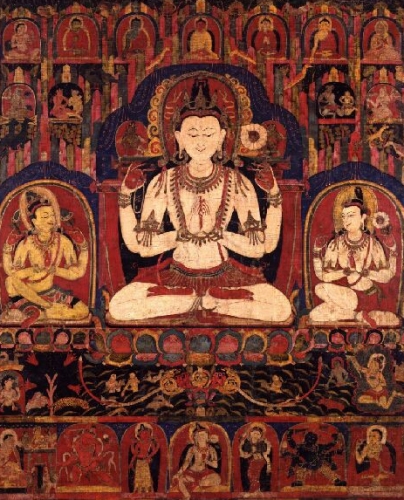Buddhist practice and Buddhist art have been inseparable in the Himalayas ever since Buddhism arrived to the region in the eighth century. But for the casual observer it can be difficult to make sense of the complex iconography. Not to worry—Himalayan art scholar Jeff Watt is here to help. In this “Himalayan Buddhist Art 101” series, Jeff is making sense of this rich artistic tradition by presenting a weekly image from the Himalayan Art Resources archives and explaining its role in the Buddhist tradition. This week we explore the various depictions of bodhisattvas.
Avalokiteshvara as a Bodhisattva

Avalokiteshvara as a Tantric Meditational Deity

The bodhisattva has become the most confusing form found in Himalayan and Tibetan art. The confusion hinges on understanding the difference between the religious definition of a bodhisattva and the artist’s definition of a bodhisattva—which is confounded by the overlap of several famous Mahayana bodhisattvas and their meditational deity namesakes in Tantric Buddhism. These are the three points of confusion.
In religious practice a bodhisattva is “an heroic aspirant to enlightenment,” as taught in Mahayana sutras. Models of these heroes can be seen in great bodhisattvas such as Manjushri, Avalokiteshvara, and Maitreya. But in Himalayan art a bodhisattva is one of eleven general figurative forms, and is defined as an idealized being in the appearance of a youthful heavenly god—generally male, a youth sixteen years of age, and richly attired in silks and jewels. Bodhisattva appearance is synonymous with peaceful appearance (deva or devi). In Vajrayana Buddhism—and associated tantric art—there are many deities that have a peaceful appearance. Not all of these deities are bodhisattvas, however, as some might be Hindu gods, wealth deities, or protectors.
To make it even more confusing, in the systems and methodologies of Tantric Buddhism figures such as Manjushri, Avalokiteshvara, and Vajrapani have been transformed into meditational deities and function as such, rather than as Mahayana bodhisattvas as taught and learned from the sutras.
A figure depicted in art may well be a bodhisattva and function as a bodhisattva, if it is depicted within a Mahayana context. The Eight Great Bodhisattvas, for instance, are almost always shown within a Mahayana context accompanying either Shakyamuni or Amitabha Buddha. However, the more famous of the Eight Great Bodhisattvas—such as Manjushri, Avalokiteshvara, and Vajrapani—are also key figures in Tantric Buddhism. In the Tantric context these figures are not understood as bodhisattvas emerging from the Mahayana narratives but rather understood to be meditational deities arising from the Buddhist Tantric literature and functioning as an object of meditation.
The two images shown above illustrate first an Avalokiteshvara figure seated in a relaxed manner looking to the side at a lotus blossom and small form of Amitabha Buddha. The second image is of Avalokiteshvara as a tantric meditational deity with one face and four arms, seated facing forward, with two attendant deities. The first image reminds us of the character of Avalokiteshvara from the Mahayana sutras. The second figure is a complex (four arms) meditational subject with mnemonic meaning applied to all aspects of the form, body, color, arms, attributes, and ornaments. Although in religious practice the two have completely different functions, in art both figures have the bodhisattva, deva/devi, and peaceful deity appearance.
In order to come to terms with this confusion it is important to understand that the term bodhisattva in Himalayan and Tibetan art also refers to a general class of appearance. Additionally, Mahayana and Vajrayana Buddhism of India that moved North to the Himalayas and Tibet had a great deal of overlap and a sharing of iconic forms such as the Eight Great Bodhisattvas.
—Jeff Watt
Suggested Links:
Bodhisattva Main Page
Definition of the Term Bodhisattva
Bodhisattva in a Mahayana Context
Mahayana Figures Transformed into Tantric Meditational Deities
Thank you for subscribing to Tricycle! As a nonprofit, we depend on readers like you to keep Buddhist teachings and practices widely available.